|
|
In 1986 the Junior League of Miami published a booklet which was a guide to historic sites in Coral
Gables. There were two self-guided walking tours which included maps. They also included the entrances, plazas and fountains,
the 7 villages, and other points of interest. The following is from that booklet.
A Downtown Walking Tour
This self-guided tour of downtown Coral Gables begins at City Hall, where on-street parking
is available. Seventeen buildings are highlighted on this one and one-half hour walk which guides you through the city's most
historic commercial area. (We cover eight through eleven.)
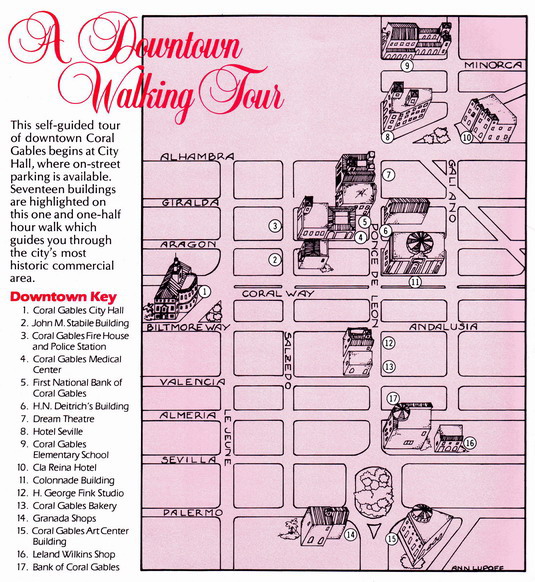
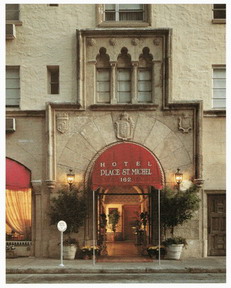 HOTEL SEVILLE
HOTEL SEVILLE
162 Alcazar – Anthony Zinc – 1926
It is hard to believe when looking at this lovely vine-covered building that it could have been anything else but a quaint country
inn, but originally it was an office building. Soon after, however, the structure was converted into the Hotel Seville.
The Hotel Seville saw many changes during its 40 years. Originally the first floor consisted of retail space. (Although much of this
area is now a restaurant, the numerous retail doors opening onto Ponce De Leon and Alcazar are still intact.) During the 1960s the
hotel went through some drastic changes: the beautiful arched ceilings were covered with dropped ceilings and flourescent lighting,
the tile and parquet floors were covered with carpeting and the original furniture was replaced by Danish Modern.
The hotel became the Place St. Michel in 1979. Extensive renovation has brought back the building's old world charm. The interior
abounds with Spanish tile and vaulted ceilings. Hanging in the main restaurant are beautiful Art Nouveau chandeliers. Throughout the
hotel the rooms are decorated with lovely European antiques.
Listed as number 8 on the walking tour map.
 CORAL GABLES ELEMENTARY SCHOOL
CORAL GABLES ELEMENTARY SCHOOL
105 Minorca Avenue – Kiehnel & Elliott – 1923-25
As more and more families in the 1920s moved into the newly established community of Coral Gables, there grew a need to organize a
school. In July of 1923, George Merrick sold this site for $10,000 to the Dade County Board of Public Instruction for the construction
of the Coral Gables Elementary School. The school was built in three phases from 1923-25. In September 1923, upon completion of the
first phase, there were 39 students enrolled, and upon completion of the final stage, the school had grown to 1,000 students.
Fronting on Ponce de Leon Boulevard, the auditorium's bayed and arched portico is topped by a second level porch supported by four
delicate masonry columns. the porch is accessed by two sets of staircases whose walls are incorporated into the facade's design. Although
this western facade is the school's most dramatic entryway, the main and original 1923 entrance fronts on Minorca Avenue.
Airy classrooms are rimmed by arcaded loggias and surround two large central courtyards. Indeed, the architectural elements of the
Mediterranean revival style are beautifully suited to the needs of a school, and while many early South Florida schools were successfully
designed in this style, few were rendered as beautifully as Coral Gables Elementary.
In 1933, the Eunice P. Merrick Courtyard was dedicated to commemorate her role in establishing the school.
Listed as number nine on the walking tour map.
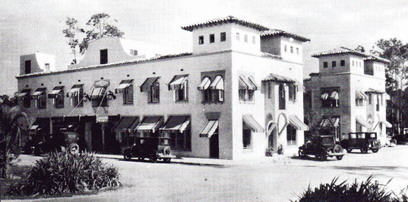 CLA REINA HOTEL
CLA REINA HOTEL
116 Alhambra Circle – H. George Fink – 1924
The Cla Reina Hotel, for years now the La Palma, offered lodging and Mediterranean ambience to some of Coral Gables' earliest visitors and
prospective residents. Of particular charm is the large interior courtyard, a tranquil gathering place for hotel guests.
Listed as number ten on the walking tour map.
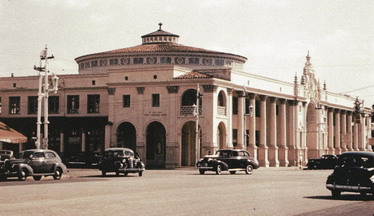 COLONNADE BUILDING
COLONNADE BUILDING
133-169 Coral Way – Phineas Paist, Walter de Garmo and Paul Chapin – 1926
One of the most impressive landmarks in Coral Gables, George Merrick built the Colonnade Building to house his sales offices. This structure
replaced Merrick's earlier, smaller office building which was located on the south side of Coral Way.
The Colonnade was designed by Phineas Paist in collaboration with Walter de Garmo and Paul Chapin, who is credited with the interior design of
Vizcaya. The structure's architecture is a mixture of Spanish Colonial and Baroque and borrows some design themes from Hadrian's Mausoleum
(Castel Sant'Angelo) in Rome. The front facade features a series of two-story columns resting on large paneled pedestals and crowned with
scrollwork and acanthus leaves. The pilasters surrounding the entrance are richly ornamented with spirals and peaks, giving an almost
wedding-cake appearance to the entrance facade. From across the street one can see peaking above the spires the 75-foot-high rotunda with
its Spanish tiled roof.
Probably the most noteworthy architectural feature of the Colonnade is its immense scale, which has allowed it to hold its own as the
impressive landmark Merrick had envisioned it to be.
Since the 1920s the Colonnade has had many tenants. In 1940 it housed a motion picture company which used the rotunda as a large soundproof
studio. During World War II the building was a training center for pilots, and when the war years were waning the rotunda became their basketball
court. Florida National Bank moved their Coral Gables branch here in 1948.
Renovation began in 1985 by Intercap Investments, Inc., with plans to include shops and boutiques filling an interior arcade connecting the
restored Colonnade with the new multi-use Colonnade tower on the north.
Listed as number eleven on the walking tour map.
In the next newsletter, Part Five will feature the buildings in the Craft Section.
Your Staff Recommends
For Your Listening & Reading Pleasure
Recommended Listening:
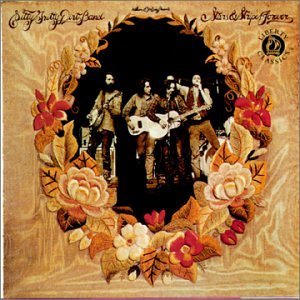 THE NITTY GRITTY DIRT BAND:"STARS AND STRIPES FOREVER"
THE NITTY GRITTY DIRT BAND:"STARS AND STRIPES FOREVER"
Originally released as a double LP in 1974. It is a combination of live concert (at Kansas State) and
Nashville studio tracks. Included are country-rock-bluegrass favorites like "Jambalaya", "Mr. Bojangles",
"The Shiek Of Araby", Buddy Holly's "Oh Boy", "The Battle Of New Orleans" and a 7-minute monolog by the
group's Jeff Hanna, "It Came From the 50's". Interspersed are interviews with legends like folk icon
Doc Watson.
Amazon.com is offering this in CD form or downloadable mp3 form (for those of you who are so inclined), both for only $5.99.
When the Beach was Hot
This article was written 17 years ago. It chronicles the hey day of Miami Beach, during
the years we were growing up. It's very long, so we are passing it along in several
installments. Here is Part One, followed by more in future newsletters.
Eisenhower was president, shark-finned Cadillacs ruled the highways, and Miami Beach was the nightlife
capital of the Western Hemisphere
By Tom Austin Wednesday, Feb 3 1993
After a long dry spell, Miami Beach is once again the nightlife capital of America, a wide-open town with nonstop action, the playground of the
Western world. The Euro-chics, the celebrated, and the simply rich, the emblems that guide the rest of the glitter-hungry world are pouring in:
Gianni Versace, Bruce Weber, Paloma Picasso, Chris Blackwell, Prince Albert of Monaco, David Geffen. Like everyone else, they are driven by publicity
and an itch for getting on the inside track to wonderland. A place where anything might happen, where everyone is young and beautiful, where life
assumes a promise that it doesn't seem to have anywhere else. A town slightly out of control, where the normal rules that govern society always seem
to be in a miraculous abeyance.
South Beach is the nightlife epicenter of the moment, but there was a time when most of Miami Beach was one big cauldron of flash and high-rollers.
It began as early as the Twenties, during Al Capone's Star Island days, peaked during the era of gambling and big-name entertainers, and began to
ebb during the Jackie Gleason period. The golden time, the years between the late Forties and the mid-Sixties, was the final great gasp of glitz
before the bleak Seventies and early Eighties, when Art Deco was not yet a viable marketing concept. But there was never anything quite like the
Beach in its heyday. Cuba was beautiful and offered perhaps more opportunities for dissipation, but it lacked the unique spin of Miami, a tropical
but still familiar American landscape. Vegas at its zenith was too overloaded, too claustrophobic, too centered on gambling. Palm Beach was closed
off to ordinary mortals. Miami Beach was, as it is now, in the right place at the right time.
In those grand old days, it was a town of unlimited potential, with a weird constellation of players that jelled into one big moment of American
pop-culture history. From the start, the moneyed crowd liked it here: old-guard names, on the order of William Kissam Vanderbilt and Coleman DuPont;
lots of imported royalty with pretension value...Lord Cromwell, the Marquis of Waterford, various European counts and princesses. The dead-ahead
WASPS, solid citizens like Gardner Cowles of Look magazine and Elliott Roosevelt, cavorting at the Surf Club (known for hiring club fighters to
entertain during dinner), the Bath Club, both on upper Collins. A society heavy with auto industry figures encouraged by pioneer developer Carl
Fisher (who had made his fortune with Prest-O-Lite acetylene gas, used for headlights) to come down and join the party: Gar Wood, Albert Champion,
James Allison, Harvey Firestone. And the money, as always, attracted the fringe crowd: sports figures, gossip columnists, real estate hustlers, con
artists, hookers, shop girls looking for husbands.
And mobsters, everybody from Meyer Lansky to Joe Adonis, men who had come down with Al Capone during Prohibition and moved into gambling and legitimate
business. By the time of Senator Estes Kefauver's investigation of Miami's organized crime network in 1950, the city was known as "the winter crime
capital of America." The infamous S&G Syndicate had bookies in every hotel, controlled the illicit gambling houses (places like the Colonial Inn in
Hallandale and the Island Club in Sunny Isles), and ran whorehouses on Second Avenue in downtown Miami. When public pressure became too intense, they
moved on to Las Vegas and Havana. And gradually some of the punch went out of the city.
But there was still plenty of juice around, and anybody who was anybody came through the Beach. A universe of legends out on the town, creating an
alchemy of pure star power, making the clubs and restaurants jump, the place to be that particular night. Elvis cavorting with the Rat Pack A Dean
Martin, Frank Sinatra, Sammy Davis, Jr., Peter Lawford, Joey Bishop A at the Fontainebleau. Maurice Chevalier dining with his wife at Le Parisien on
41st Street. Jimmy Durante laughing with singer Jerri Pollak, now a Miami stockbroker, at the Eden Roc. Martha Raye holding down the fort at the Five
O'Clock Club, the legendary one-for-the-road joint on 22nd Street. One block away on 23rd, the three graces of raunch... Belle Barth, Patsy Abbott, and
Pearl Williams of Place Pigalle...at Patsy's Place. Marlene Dietrich and Nat King Cole dining together at the Eden Roc. Tennessee Williams and Gloria
Swanson at the Embers on 22nd Street. Joe E. Lewis and Frank Sinatra nearby at Murray Franklin's. An all-star lineup...Dean Martin, Milton Berle, Tony
Martin, Marie McDonald, Walter Winchell, Earl Wilson, Roberta Sherwood...on parade at the Latin Quarter. Jack E. Leonard and Uncle Miltie hosting a party
for the Footlighters (an association of male comics), Berle mugging and grabbing his crotch for the cameras. An endless procession of the famous...Bob
Hope, Jayne Mansfield, Sophie Tucker, Jack Benny...dropping in on clubs with intensely atmospheric names: the Black Magic Room, the Neptune Lounge, the
Copa.
Plenty of celebrity firepower, and lots of laughs and sex, the essential components of nightlife. Rumors of "buffet flats," South Beach hotels with
different sex shows on each floor. As with the modern epoch, the Beach had a considerable number of gay bars, the clientele favoring suits and ties
rather than Spandex shorts: the Charles in the Charles Hotel on Collins Avenue, where female impersonator Charles Pierce started out; the Echo Club
on Collins at Tenth; Billy Lee's on Alton Road at Dade Boulevard, with a notorious back room that was periodically raided. Then as now, people tended
to get carried away on the Beach. John Jacob Astor VI, an incorrigibly decadent playboy, was known to hire a half-dozen women at a time for his lavish
private parties. Even at the elegant Surf Club...run by Alfred Barton, a former Hollywood art director who counted Noel Coward among his friends... an
incident of sorts was provoked when the actor Clifton Webb became infatuated with one of the pool boys.
(End Part One. Part Two will be continued in the next newsletter)
Jeopardy Questions
Answers for quiz seen above
| 1. |
|
What was RC Cola? |
| 2. |
|
What are bats? |
| 3. |
|
What is counterfieting? |
| 4. |
|
Who was Charles Lindbergh? (1927) |
| 5. |
|
What was "The Godfather II"? (1974) |
| 6. |
|
What is California? (Maine is second.) |
| 7. |
|
What is "matinee"? |
| 8. |
|
What is the Minneapolis Metrodome? |
| 9. |
|
What is 42? |
| 10. |
|
What are Pennsylvania, Kentucky, Massachusetts and Virginia? |
| |
|
|
|
|
|
|
Photo Gallery
|
|
|
|
| We welcome photos, both present and past, from all classmates. |
| |
|
|
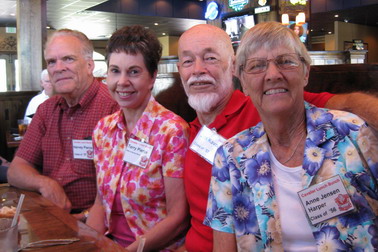 |
|
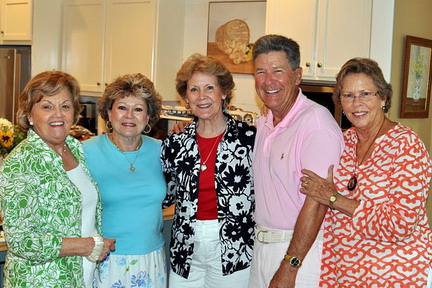 |
Harvey Pierce, Terry Pierce, Jim Kavney and Anne Jensen Harper attended
the June 16th gathering of the Cavalier Lunch Bunch. The luncheon was held
in Ocala at the Horse & Hound. |
|
Lynn Ezell Hollingsworth, Jeneal Leonard Benton, Beth McDonald
Johnston, Bill Sutton, Mimi Johnson Monroe enjoy getting together
in North Georgia at Sondra Welch's lake house. |
| |
|
|
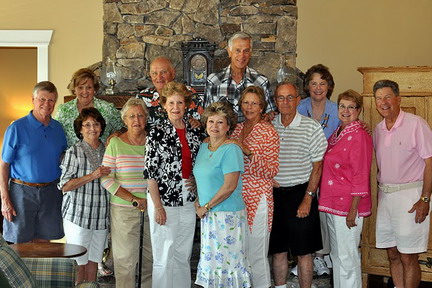 |
|
 |
Gables grads attending the party at Sondra Welch's lakehouse.
Row one: Don McLean, Sondra Welch McLean, Marilyn Mayes Hicks, Beth McDonald Johnston,
Jeneal Leonard Benton, Mimi Johnson Monroe, Holt Garrard '54, Lyndall Blackburn Doxey, Bill Sutton.
Row Two: Lynn Ezell Hollingsworth, John Towle, Charlie Munroe, Linda Rollins Brown. |
|
Annette Crofton Cowart visits Graceland. Elvis had left the building. |
| |
|
|
.
 |
|
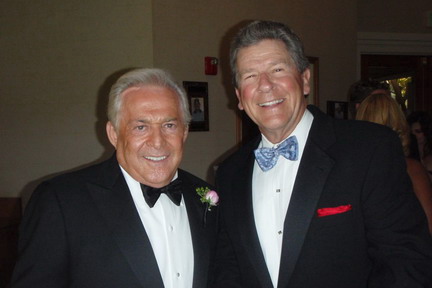 |
| Sharron and Stewart Harnell are proud parents at their son's recent wedding. |
|
Stewart Harnell and Bill Sutton at Stew's son's wedding. |
| |
|
|
| |
|
| |
|
|
| |
|
|
|
|



 HOTEL SEVILLE
HOTEL SEVILLE CORAL GABLES ELEMENTARY SCHOOL
CORAL GABLES ELEMENTARY SCHOOL CLA REINA HOTEL
CLA REINA HOTEL COLONNADE BUILDING
COLONNADE BUILDING THE NITTY GRITTY DIRT BAND:"STARS AND STRIPES FOREVER"
THE NITTY GRITTY DIRT BAND:"STARS AND STRIPES FOREVER"





